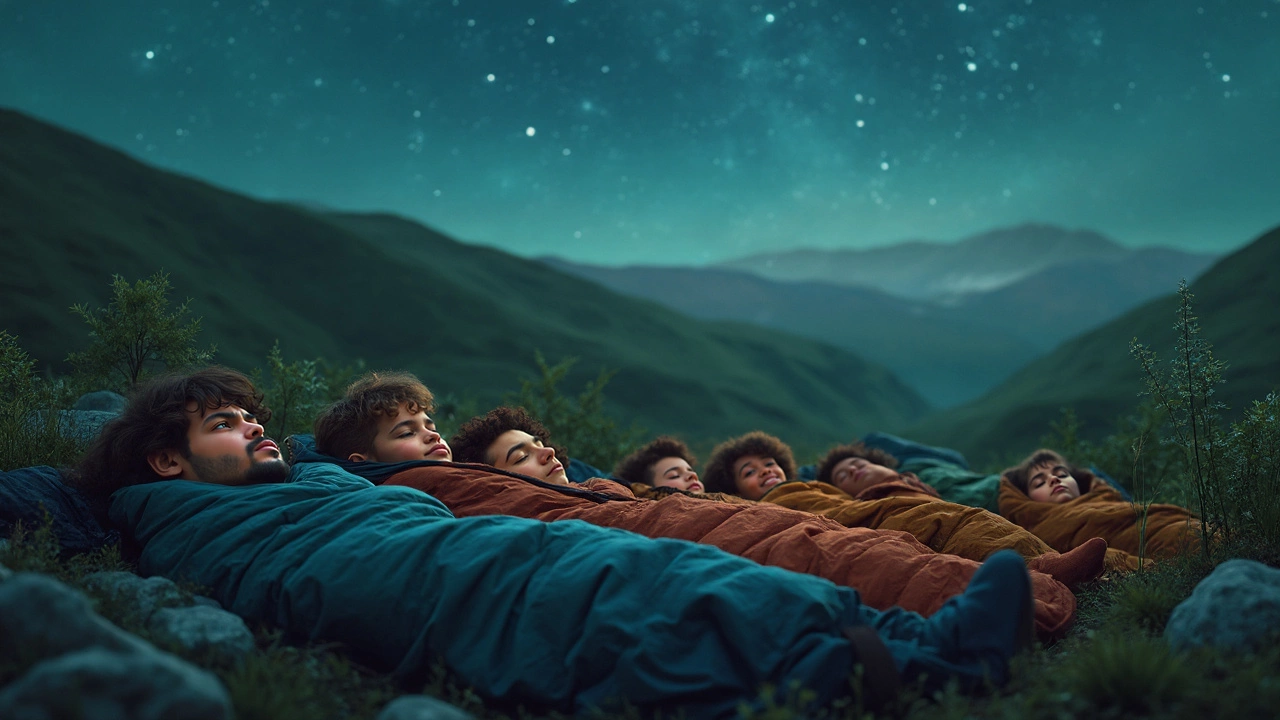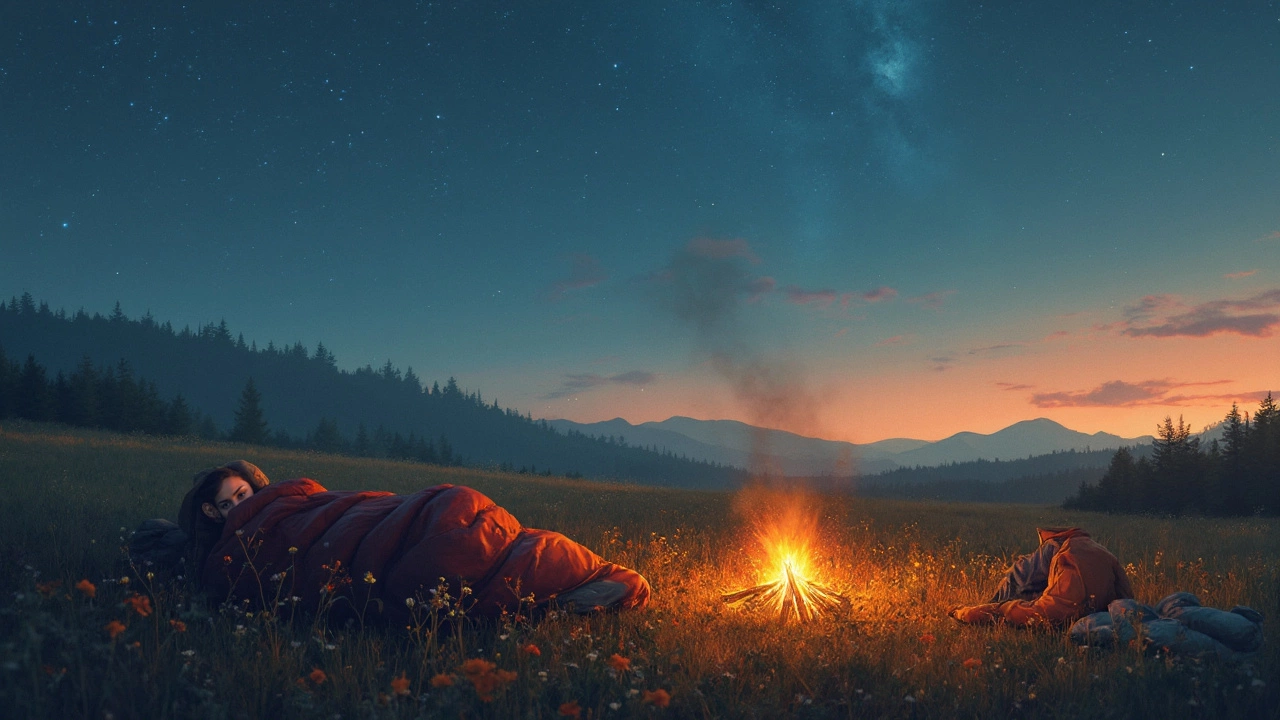Exploring Cowboy Camping: The Ultimate Eco Experience
12 Apr, 2025Alright, let’s talk cowboy camping. It's not about spurs and lassos, but about ditching the tent to sleep under the stars. Imagine hitting the hay with nothing but a sleeping bag between you and the universe. This type of camping isn’t just for seasoned outdoorsy folks; it’s for anyone craving a raw connection with nature.
You’re probably thinking, 'Why would anyone give up the comfort of a tent?' Well, cowboy camping offers a few surprises. First off, it cuts down on gear. Less stuff means you’re light on your feet and your backpack thanks you for it. Not to mention, fewer things mean you’re reducing your environmental footprint. Who doesn’t like being eco-friendly while keeping it simple?
But let's get real; it's not just about saving the planet. It’s about the thrill of waking up to the sunrise kissing your face or the soundtrack of chirping crickets singing you to sleep. You get to experience nature in its purest form—and that's something a tent can sometimes shield you from.
- The Essence of Cowboy Camping
- Gear Up for the Adventure
- Choosing the Perfect Spot
- Benefits of Going Tent-Free
- Safety Tips and Tricks
- Embracing Nature: The Eco Angle
The Essence of Cowboy Camping
Cowboy camping is about embracing the great outdoors with minimal fuss. It’s like hitting the 'easy mode' button on camping. The idea is to simplify and reconnect with nature by ditching the tent. This style brings a raw, adventurous vibe as you’re literally sleeping under the open sky.
The origins of cowboy camping can be traced back to the old west, where cowboys slept on the ground, relying on the stars as their ceiling. Fast forward to today, and it's a beloved practice for those seeking an intimate nature experience. Whether you're on a backpacking adventure or just looking to try something new, it's about stripping back the camping essentials to a good sleeping bag, a suitable mat, and a trusty tarp if the weather decides to rain on your parade.
The beauty of cowboy camping lies in its simplicity. There's no setup or teardown like traditional camping—what you see is what you get. You drop your pack, lay out your gear, and you’re set. It couldn’t get any more straightforward.
But let’s not gloss over the need for some basic prep work. Sure, you'll skip the tent, but picking the right spot is crucial for comfort and safety. You'd want to avoid areas with critters or unpredictable weather. Keep an eye on the forecast because being too adventurous with this style of camping can lead to soggy mornings if rain catches you off guard.
Additionally, this approach can be more eco-friendly. Less gear means reduced manufacturing impact and a smaller footprint, which helps keep those natural spots pristine. It’s a peaceful protest against over-consumption wrapped in the guise of adventure.
In short, this isn’t just about skipping the tent; it’s about embracing a new outlook on outdoor living. An opportunity to taste the thrill felt by those early wanderers who ventured into the wilderness with little more than a bedroll and sheer spirit. Dive into this bare-bones experience for an awe-inspiring connection to the world around you.
Gear Up for the Adventure
Getting ready for cowboy camping is a breeze, but you’ll want to ensure you have the right gear to keep things comfortable and safe. No tent, no problem—here's how you do it right.
First off, the star of your gear lineup is your sleeping bag. You’ll want one that's suited for the climate where you’re camping. If you're heading out in mild weather, a lightweight sleeping bag will do the trick. Planning an adventure in chilly conditions? Opt for a bag with a lower temperature rating.
- Sleeping pad: Don't skip this. It provides insulation and comfort, protecting you from chilly ground and those unexpected stones poking your back. Look for inflatable ones; they're easy to carry and set up.
- Tarp or bivvy sack: These are lifesavers, literally. A tarp can serve as an impromptu shelter against unexpected rain, while a bivvy sack offers additional warmth and protection.
- Headlamp: Essential for when the sun goes down. You never know when you might need to find something in your pack or read a map.
- Bug protection: A mosquito head net or some good ol' bug spray keeps the pests at bay, which is great for a peaceful night under the stars.
Layering is key, so pack some good base layers. You'll want to manage your body temperature easily with not too much bulk. Waterproof footwear is a must; you don't want soggy feet ruining the vibe. Oh, and while we’re going minimalist, don’t forget the basics like a multi-tool, a first-aid kit, and enough water.
Making smart choices about your eco-friendly gear not only enhances your experience but also aligns with the core of cowboy camping: treading lightly on the Earth. So pack wisely, and you’ll be all set!
Choosing the Perfect Spot
Finding the right spot for cowboy camping can make all the difference between an epic night under the stars and a rough night on uneven ground. First, look for flat, dry ground—the last thing you want is to roll into a puddle at 3 a.m. A clear, dry area helps keep you comfy and dry.
Check for natural windbreaks. Camping against a rock or in a dip can save you from feeling like you’re in a wind tunnel. But, watch out for spots where water might collect, like dry riverbeds, in case of unexpected rain.
Next up, position yourself under the stars but not under a hazard. That means steering clear of dead trees or branches that might decide to join you mid-snooze. Look for areas with some trees or rocks nearby—they can provide shelter without the whole "sleeping in a tree" risk.
Think about the view. Part of the outdoors magic is waking up to a killer sunrise or sleeping under a blanket of stars. So if you can, position your sleeping bag to face east since nothing says 'good morning' like a natural light show!
Finally, always remember the cardinal camping rule: Leave no trace. Before you set up, make sure that your selected spot is in a designated camping area or ensures minimal impact on the environment. Pack out everything you brought in and leave nature just the way you found it—or better!

Benefits of Going Tent-Free
Why would you leave the trusty tent behind and throw caution to the wind with cowboy camping? Well, there are some pretty compelling reasons to go tent-free. For one, it's all about fostering a deeper connection with nature. Sleeping out in the open lets you soak in every rustle of the leaves and every twinkle of the stars.
When you ditch the tent, you also gain mobility. It's a lot easier to find the perfect sleeping spot when you're not bogged down by poles and stakes. That flexibility means you can follow the views and settle in at the best spots—no more squeezing into rocky or uneven sites just because they're "tent-friendly."
From an environmental angle, camping without a tent leaves a smaller footprint. Fewer materials are used, and that means less waste. It's a no-brainer for anyone looking to keep their adventures sustainable. Not having to deal with a tent can also simplify packing and make those long hikes a breeze. Who doesn’t love cutting down on weight?
- Cost-Effective: No tent means one less thing to buy, making your trip lighter on the wallet, too.
- Quicker Setup and Breakdown: You literally unroll your sleeping bag and you’re good to go. More time for exploring, less time wrestling with tent poles.
- Enhanced Experiences: Imagine falling asleep under a meteor shower or waking up to a sunrise without anything obstructing your view.
If you're worried about comfort or safety, just know that with the right preparation and gear, cowboy camping can be a rewarding and cozy experience. All in all, going tent-free is a way to embrace nature and simplify your outdoor routines. It's you, the earth, and the open sky.
Safety Tips and Tricks
So you’re ready to embrace the great outdoors and give cowboy camping a shot? Awesome, but let's make sure you’re doing it safely. There's no tent acting as your fortress, so you’ve gotta be smart and prepared. Here are some tips to keep you safe while you enjoy sleeping under the vast, open sky.
First off, keep an eye on the weather. No one wants a surprise downpour when they’re sleeping. Check the weather forecast before heading out, and plan to camp only on clear nights. If there’s even a hint of rain, maybe opt for a tarp you can quickly set up over your sleeping gear.
Next, think about critter encounters. We share nature with all sorts of wildlife, and some of it likes to rummage for snacks. Keep your food away from your sleeping area. Use bear-proof containers if you're in bear country or just keep everything sealed and distant.
Staying warm is crucial too. Temperatures can drop significantly, especially in the mountains or desert. Bring along a high-quality sleeping bag appropriate for the nighttime temp. Consider packing a thermal layer to wear if you need extra warmth.
Lighting is your friend. Nothing’s worse than fumbling around in the darkness. A good headlamp or flashlight will help you set up or break down in the dark and navigate to wherever your bathroom spot may be.
- Always inform someone about your camping location and expected return time.
- Bring plenty of water or have a plan to purify natural sources.
- Familiarize yourself with potential hazards of the area, like certain plants or animals.
And don’t forget about your trusty cell phone. Charge it fully before heading out, and keep it in a waterproof case. Though you’re out to relax, it’s handy in emergencies.
Embracing the eco-friendly philosophy of cowboy camping means leaving no trace. Respect the land as you found it, pack out all your trash, and enjoy the unfiltered beauty safely.
Embracing Nature: The Eco Angle
So, why is cowboy camping such a big deal for the planet? It's all about reducing your footprint, quite literally. By skipping the tent, you’re not only lightening your load but also your impact on nature. Tents often require synthetic materials like nylon and polyester, which aren’t exactly Mother Nature’s best friends.
Now, think about energy consumption. Setting up a tent involves gear like poles, stakes, and sometimes air pumps for inflatable tents. With cowboy camping, a sleeping bag and maybe a ground tarp are all you need. Less gear means fewer resources need to be manufactured, which is a win for sustainability.
Plus, this style of camping encourages adventurers to be more mindful of their environment. You’re sleeping right on the ground, so you become extra aware of what you’re doing to the earth beneath you. This connection often results in campers being more cautious about leaving waste behind.
Another interesting aspect of cowboy camping is its minimalism. Reducing your gear takes a step back from consumer culture, which is pretty refreshing these days. It’s all about enjoying what we have without constantly wanting more. This mindset goes a long way in promoting sustainable practices beyond just camping.
Here's a cool tidbit: according to a survey by Camping Magazine, 60% of campers who tried going tent-free reported feeling more connected to nature and were motivated to adopt more eco-conscious habits in their daily lives.
So, embracing cowboy camping isn’t just about adventuring without barriers; it’s also a pledge to preserve the beauty of our natural landscapes for generations to come. By keeping it simple and responsible, you’re showing some serious love for the great outdoors.

 by
by